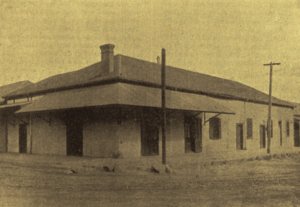Casa de Castelar facts for kids

Casa de Castelar (1897)
|
|
| Named after | Emilio Castelar |
|---|---|
| Established | February 1894 |
| Dissolved | 1910 |
| Purpose | social reform |
| Location |
|
|
Region served
|
Sonoratown, Los Angeles |
|
Parent organization
|
Los Angeles Settlement Association, a subsidiary of the College Settlements Association |
Casa de Castelar (also known as The College Settlement) was a special community center in Los Angeles, California. It opened in February 1894. It was part of a movement called the settlement movement, where people lived in neighborhoods to help others.
Casa de Castelar was the very first settlement house in Los Angeles. It was also the first one west of the Mississippi River! It was started by a group called the Los Angeles Settlement Association (LASA). This group was part of a bigger organization called the College Settlements Association.
Contents
What Was Casa de Castelar's Goal?
The main goals of Casa de Castelar were to:
- Create and run community centers in Los Angeles.
- Learn about and improve the lives of people in those areas.
- Help people from different backgrounds understand each other better.
- Work with other groups to make social conditions better for everyone.
The center got its money from donations and monthly payments from supporters.
How Did It Start?
The idea for Casa de Castelar came after Jane Addams visited Los Angeles in the early 1890s. She was famous for her work at Hull House in Chicago. A group of college women in Los Angeles were inspired by her and other similar centers.
These thirteen women were from the Los Angeles College alumni group. They decided to open their own center. In its first year, Evelyn L. Stoddard was the president.
Why Was Sonoratown Chosen?
A spokesperson named Maude B. Foster explained why they picked the Sonoratown area. She said it was "the most exclusive and most congested part of the city." This meant it was a busy area with many people living close together.
The center welcomed people from many different backgrounds. Visitors included Spanish-Mexican, Italian, French, German, and Assyrian people.
Early Activities and Clubs
For three years, the center grew and helped many people. They had a daily kindergarten for young children. They also had seven clubs for women and children of all backgrounds.
Some of the clubs included:
- The Isabella Club, for girls.
- La Primavera Club, where young men enjoyed music and social events.
- El Club Esperanza, for young unmarried people over 16 to talk about money and social topics.
Casa de Castelar also had a library and a savings bank. They offered different classes and lectures too.
Where Was Casa de Castelar Located?
The College Settlement was in the oldest part of Los Angeles, once called El Pueblo de Los Angeles. The people living in this area were from many different countries. They included Spanish-Mexican, Italian, French, Basque, Syrian, and Slavonian families.
The center moved a few times:
- February 1894: Alpine and Cleveland Streets
- 1894: 629 New High Street
- December 1895-1898: Casa de Castelar, Ord and Castelar Streets
- 1898–1910: 428 Alpine Street
The Main Building
In 1897, the center moved into a special building in Sonoratown. It was at the corner of Alpine and Castelar Streets. This building was owned by the Los Angeles Settlements Association. It was thought to be the first adobe (a type of mud-brick) settlement building ever recorded.
At this time, The College Settlement changed its name to Casa de Castelar. This was because it was on Castelar Street and honored Emilio Castelar, a Spanish politician.
That same year, a small branch of the Los Angeles Public Library opened at the center. They also offered a kindergarten, sewing clubs, and other classes.
How Casa de Castelar Helped the City
The people who worked and volunteered at Casa de Castelar cared deeply about their community. They helped start many important public services in Los Angeles.
Here are some of the things they helped create or improve:
- Public Health Nurses: They helped bring the first public health nurse to Los Angeles. This nurse was paid by the city. The settlement workers showed how important this job was. They even housed the nurses at the center. Eventually, public health nursing became a regular part of the City Health Department.
- Juvenile Court: The very first meeting to create a juvenile court for Los Angeles County happened at Casa de Castelar. The workers spent a lot of time and effort to help set up this court.
- Playgrounds: The Los Angeles Playground Department got a lot of help from these settlement workers. They worked together to create places for kids to play.
- Housing Bureau: They also helped create the Housing Bureau for the City of Los Angeles. They did the first studies to show why this bureau was needed.
- Inspiring Others: Casa de Castelar inspired other people to start similar community centers in different parts of the city.
- English Classes: The first English classes for adults were held at Casa de Castelar. Later, these classes moved to the public school system.
In 1910, Casa de Castelar stopped its direct settlement work. However, its impact continued through the many city services it helped create.
Notable People Who Helped
Many people who worked at Casa de Castelar later held important roles in the city. Some of them included:
- Bessie D. Stoddart: Secretary for the playground commission.
- Evelyn L. Stoddart: Chaired the probation committee for the juvenile court and was on the visiting nurses' committee.
- Maud Foster Weston: Director of visiting nurses.
- Mary Adair Veeder: Member of the housing commission.
- Mary H. Bingham: On the visiting nurses' committee and a probation officer.
- Louise Barber: A probation officer.

